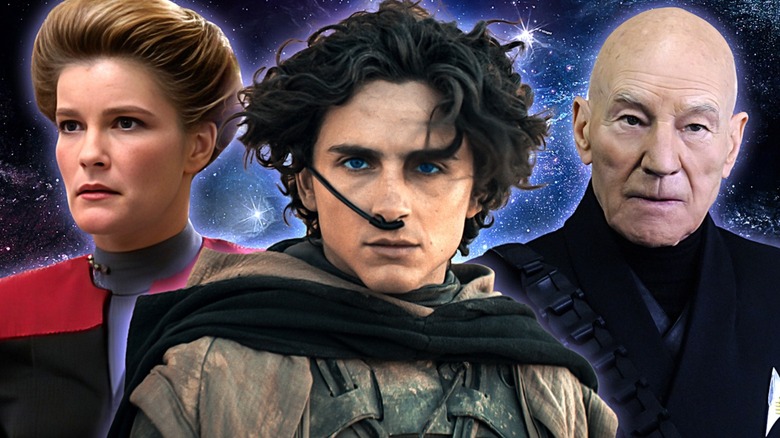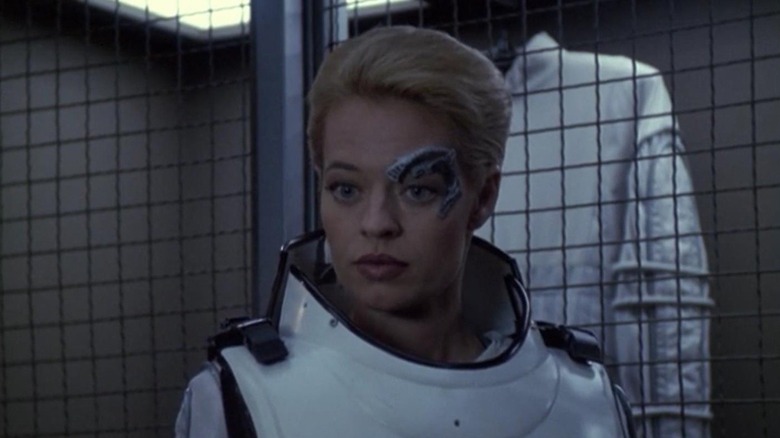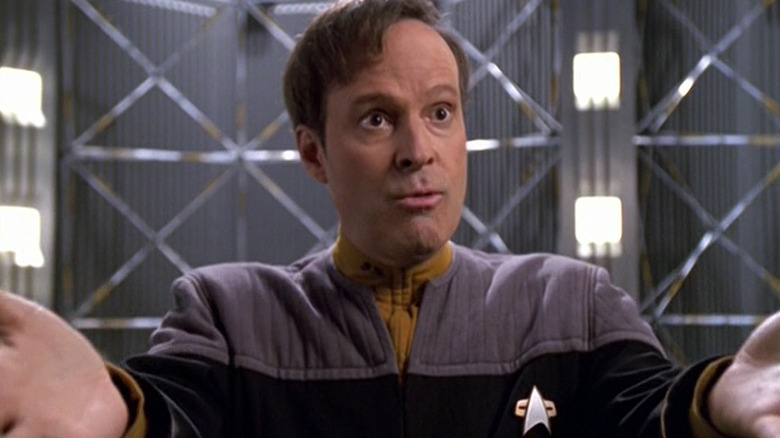Star Trek Features Some Brilliant References To Frank Herbert's Dune
Frank Herbert's "Dune" has a longer timeline than one might expect. The first book takes place in the year 10,191 A.G., referring to a time after the inception of the Spacing Guild, the organization devoted to faster-than-light travel. Later sequels refer to the year 11,200 B.G. as the year humans first developed space travel, lining it up with A.D. 1960. "Dune," then, takes place about 20,000 years in the future.
"Star Trek," in contrast, takes place in the relatively near future. The original series takes place in the 23rd century, and "Star Trek: The Next Generation" — and its immediate spinoffs "Star Trek: Deep Space Nine," "Star Trek" Voyager," and "Star Trek: Lower Decks" — all take place in the 24th century. Extending the timeline, "Picard" takes place in the early 25th century, and the bulk of "Discovery" takes place in 32nd century, thanks to a time warp. Comparatively, those are small temporal potatoes when compared to "Dune."
Sadly, the lore of "Dune" is so involved and unique, one cannot squint their eyes and pretend that the two franchises take place in the same universe. Their respective histories are simply too different.
But that hasn't stopped the makers of "Star Trek" from dropping in a few "Dune" references from time to time. The writers of "Voyager" are, as one might expect, science-fiction nerds, and would, in tiny ways, drop in references to other sci-fi stories. Trekkies will be able to tell you about a planetary manifest on the U.S.S. Enterprise that, when examined closely, list the planet of Alderaan, the planet the Galactic Empire blows up in "Star Wars: Episode IV — A New Hope."
On "Star Trek: Voyager," there have been passing references to planets within the "Dune" universe as well, particularly Arrakis (a.k.a. Dune) and Geidi Prime, the home planet of House Harkonnen.
Arrakis Prime
In the "Voyager" episode "One Small Step" (November 17, 1999), the U.S.S. Voyager finds a mysterious subspace ellipse that may contain a 300-year-old Mars vessel inside. Captain Janeway (Kate Mulgrew) assigns Seven of Nine (Jeri Ryan) to go inside with Tom Paris (Robert Duncan McNeill) and Chakotay (Robert Beltran) to investigate, leaving the rest of the crew envious at their opportunity. The Doctor (Robert Picardo) asked that Seven bring along a camera and to take some pictures inside the ellipse, knowing it would provide uniquely beautiful images. Seven seems unimpressed, but the Doctor explains how awesome it is to be standing among remote spatial phenomenon. "I can only tell you how I felt that morning I materialized on Arrakis Prime," the Doctor says. "I left my footprints in the magnesite dust and thought, 'One small step for a hologram, one giant leap for mankind.'"
Whether or not the Doctor visited the same Arrakis from "Dune" will have to remain the subject of nerdy fan speculation.
In the "Voyager" episode "Drive" (October 18, 2000), B'Elanna Torres (Roxann Dawson) plans on taking her husband Tom on a romantic getaway on the Voyager's holodeck. She plans on taking him to Gedi Prime, described as so beautiful, it makes the famed resort world Risa look like a tourist trap. It's also said to have excellent golf courses. Sadly, their vacation is delayed when Tom gets involved in a high-speed starship race.
Geidi Prime, as mentioned, is the homeworld of the evil House Harkonnen in "Dune," only it's decidedly not beautiful. It's mechanical, dark, oily, and gross. Repurposing Geidi Prime as one of the most beautiful of all planets is likely a cute joke on the part of the "Voyager" writers.
Gedi Prime, Geidi Prime
As "Voyager" progressed, the ship was eventually able to start communicating with the Alpha Quadrant, still many, many years away at maximum warp. Indeed, information could be shunted back and forth from the Voyager's holodeck and the holodeck belonging to Reginald Barclay (Dwight Schultz) back home. This allowed face-to-face interaction between the remote locations, and a few amusing conversations held by Barclay and the Doctor. The two liked being in each other's company, and the Doctor even suggested that the pair visit the Gedi Prime golf course. It's not exactly the same as Geidi Prime (the subtitles on the "Voyager" DVDs do indeed say "Gedi" and not "Geidi"), but it's close enough to be considered a definite reference.
One can also point out that Patrick Stewart, who played Captain Picard on "Star Trek: the Next Generation," also appeared as Gurney Halleck in David Lynch's 1984 film adaptation of "Dune." Also that Brad Dourif, who played Piter De Vries in "Dune," also appeared in three episodes of "Voyager" as a Betazoid. In Denis Villeneuve's 2021 film version of "Dune," actor Babs Olusanmokun played a Fremen warrior named Jamis, and he also plays Dr. M'Benga in the modern "Star Trek" show "Star Trek: Strange New Worlds."
As mentioned, the histories of "Star Trek" and "Dune" are too different for the two franchises to intersect in any kind of meaningful way, so there shan't be any crossovers in the near future. "Star Trek" employs warp engines to zip around the universe, while "Dune" uses a psychedelic spice. Also, "Dune" takes place in a deeply religious, markedly mystical universe, whereas "Star Trek" takes place in a post-religious, deeply humanist universe. But one can be sure that fans of one are most assuredly fans of the other.


